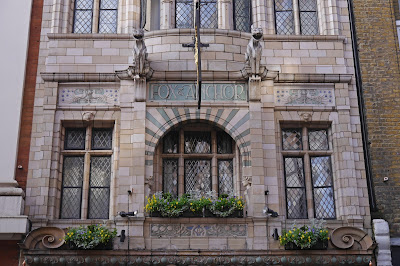The Charterhouse
It was too wet and muddy to walk in the country, so we decided on another walk in London from the excellent London's Hidden Walks (vol 2) by Stephen Millar. We weren't entirely sure where Clerkenwell was, but it turns out to be the area between Barbican and Farringdon. Starting from Barbican tube station you walk through Charterhouse Square to reach the Charterhouse, once a medieval hospital, then an almshouse and school and finally, from 1872, only an almshouse.
I already knew about the Charterhouse, but a short distance away along Charterhouse St, was a wonderful surprise: the art nouveau Fox and Anchor pub dating from the 1890s. We would have gone in to investigate further had it been open ...
Now across the road and through the centre of Smithfield meat market to West Smithfield, a pleasant sort of square, with some nice eateries - although it was once apparently a place of public execution (William Wallace, to whom there is a monument bedecked with Saltires, was one such unfortunate.) Tucked away in the corner is the hidden gem of St Bartolomew the Great, the "finest Norman church ion London". A service was underway, so we couldn't go in, but there are some nice photos in the City West walk I did a couple of years ago.
St Bart's hospital is around the corner and, unusually, it has a church inside its boundary, St Bartholomew the Less. Its tower can be seen in the photo below behind Henry VIII's gate, the main entrance to the hospital.
Coming back through Smithfield, we were struck by the beauty of the iron arches over the road.
Now the route heads north and we lost our way momentarily, but this did lead us past this intriguing house in Peter's Lane.
Going along St John's St we came on another surprise, the medieval St John's gate, the surviving part of the Priory of the Knights of St John of Jerusalem (or Knights Hospitaller, founded in 1099). The second surprise was that was site has been owned since 1872 by the British Order of St John, founders of the St John Ambulance Brigade, which is still headquartered there.
Soon after this we were in Clerkenwell Green, with the 18th century St James's church off to one side.
At the end of Clerkenwell Green there is a housing development by the Peabody Trust and nearby the Horseshoe pub, a cosy example from the early 19th century.
Just round the corner is the former Hugh Myddleton school, now converted into apartments. Our route takes us past the front and round to the back where there were three entrances: Boys, Girls & Infants, and Special Girls. What were Special Girls? Was that good or bad?
Soon we pass through Exmouth Market and and turn left into Farringdon Rd, passing the Mount Pleasant Sorting Office and later the Coach and Horses pub in Herbal Hill which runs parallel. In the road outside the pub is a grille under which runs the River Fleet, hidden underground since the mid-19th century.
Off to the left there is a glimpse of this wonderful house, Abbots Court, in Farringdon Place. I can't find out anything about its history.
And back in Farringdon Road is this Victorian gem in the style of a Venatian palazzo. Again, I would love to know more.
Returning now to the route, we walked further along Herbal Hill and turned right into Clerkenwell Road to see the wonderful Italian church founded in 1853. This area was home to many Italian immigrants in the 1850s and clearly still remains an Italian enclave: it was noticeable how many people we heard in the streets nearby speaking Italian.
Finally, we walked through Hatton Garden, with many jewellery shops open even on a Sunday afternoon, to pass the hidden Ye Olde Mitre Tavern, dating from 1546, and reach Ely Place. Here stood Ely House, the grand London residence of the Bishops of that town. The church of St Etheldra, dating from 1290, is the only surviving part of Ely House.
From here, it was a short walk to Farringdon Tube station.
Conditions: cold but sunny.
Distance: about 3 miles.
Rating: Four stars.














No comments:
Post a Comment